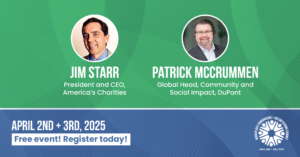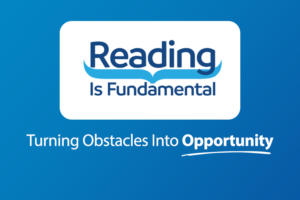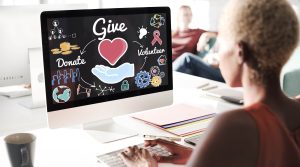Steve Delfin | November 6, 2012
Engaging Millennials in Workplace Giving
Mutually Beneficial Actions Employers & Charities Can Take to Leverage Each Other’s Millennial Engagement Efforts
I’ve been working in and around the world of philanthropy my entire professional career. So I think it is fair to say I’ve gained some valuable perspectives particularly around employee engagement and workplace giving. One thing that never ceases to amaze me is how important it is to connect donors with opportunities to directly engage with the charities they support or are considering supporting. Why is this important? Without getting too deep into the research, it is clear that people give for two primary reasons:
- They are asked by someone they respect and trust.
- They are engaged with a charity or cause either directly as a volunteer or intellectually because they support an issue or person impacted positively by the cause.
Here’s why these two factors are particularly critical as they relate to millennials:
- Higher Expectations: Millennials (born roughly between 1980 and 2000) have higher expectations of their employers as it relates to opportunities to “give back.”
- More Informed & More Engaged: Millennials are more informed and more engaged with community service and philanthropy than previous generations. Think about it. Many public and most private schools began requiring or strongly encouraging some form of “community service” beginning in the mid to late 1980s or about the time that the first cohort of Millennials were heading off to kindergarten with their Cabbage Patch lunch boxes (or was it Transformers?). So the idea of volunteering and giving back has been part of their education and engrained in their viewpoint of the world.
These are both very good things. This young, socially aware and engaged generation of employees creates some very interesting challenges and opportunities for employers and charities alike, but it seems to me that employers and charities are working from different sides of the same coin when it comes to leveraging these similar challenges and opportunities.
How can each leverage the other in ways that will mutually benefit and result in a more robust, engaged experience for the younger employee?
Here are some thoughts for employers and for charities:
For Employers:
1. Think beyond the “tried and true” approach:
- Many employers stick to the “tried and true” methods they are familiar with, while millennials perceive those “tried and true” methods as stale and outdated. This is particularly true when it comes to employee workplace giving campaigns. While more and more employers have moved away from the “United Way only” model, many have not evolved their efforts beyond adding more charitable choices and using more robust technology to drive their giving campaigns.
- Look outside your company or organization for new ideas, strategy and creativity. What we at America’s Charities advocate is a strategic approach that connects the best of the “tried and true” with the new reality and expectations of today’s younger employees. We believe that your employee volunteering and workplace giving programs should connect strategically to your broader employee engagement and social responsibility efforts. Connecting these “activities” to strategic, measurable outcomes will (a) leverage the best of the tried and true to generate more meaningful employee volunteerism, more meaningful and higher giving rates in your workplace giving campaigns; and (b) provide more cohesion and strategic relevance to the bigger social responsibility goals that your company or organization has set forth.
2. Engage Millennials on their own terms:
- This means better use of technology in ways that are consistent with how Millennials use technology outside of the workplace. America’s Charities’ workplace giving and employee engagement technology solutions run the gamut from basic to highly sophisticated, and appeal to multiple generations in the workplace.
- This also means providing additional tools that allow (and encourage), employees to share with each other their experiences and reasons for donating and volunteering for the causes they support.
3. Discover & embrace your role as “Opportunity Facilitator”:
- Trust and opportunity are big issues for millennials. They trust their friends to help them make choices and they look to their social network for validations. The workplace is viewed as part of that social network and, therefore, the expectation is that the workplace should facilitate the opportunity for them to execute their “giving” agenda.
- Embrace the opportunity to play your important role as “opportunity facilitator” by providing year-round opportunities for engagement, volunteering, and information sharing. Millennials want to support charities with their time as well as with money. As the “opportunity facilitator” you could encourage them to take on leadership roles that connect them (and your company) more directly with charities (i.e. Workplace Giving Ambassador, attending charity events, etc.). If you as an employer can do this, you can become part of that circle of trust that younger employees seek. And as a result, those employees will be more loyal to you and might even be more supportive of your company’s “giving” agenda.
4. Make it easy for millennials to connect & make educated, informed choices:
- Millennials want to make educated and informed choices. Sure they rely on their friends and networks for validation, but they’ve grown up on the Internet. They know how to find and research the organizations and causes that meet their interests, but why not make this easy for them and be transparent about it? With workplace giving technology like America’s Charities’ solution, employees can find all the charity information they need in one convenient place. Plus, our technology solution makes it easy for employers to be transparent about the costs and processes involved with making donations. So there are no surprises and no guesswork – the employee knows how much of their money the charity will actually receive and they know the impact that their donation will actually have.
- Nothing – and I mean nothing – takes the place of face-to-face interaction though, which takes us back to the best of the “tried and true.” In workplace giving two things are constant:
(A.) Volunteering leads to giving, so it is always a great strategy to provide employees the chance to volunteer on company time if possible (and we realize that’s not always the case), and
(B.) Direct exposure to charities and stories about their beneficiaries drives giving and volunteering like nothing else. It used to be that story-telling could only happen by having charities come in to make face-to-face presentations. That’s still very effective and America’s Charities will gladly work with you to bring charity speakers to your workplace, however; the reality of today’s workplace is that your employees work remotely or at multiple work sites, so face-to-face interaction isn’t the easiest option. That’s where social media and other interactive media come into play. Employers should turn to the charities participating in their workplace giving programs and seek ways to connect employees with their causes. This could be as simple as sharing a charity’s YouTube video, encouraging employees to connect with charities on various social media sites, or even utilizing newer platforms like Google+ Hangout which allows for that face-to-face charity speaker interaction, while allowing for employees to be at different locations.
For Charities:
Many charities look at workplace employee giving as “found money”. They join a federation like America’s Charities, sit back, and whatever rolls in the door rolls in the door. It’s passive fundraising. There is a better way particularly as it relates to millennials.
1. Saying “Thank you!” could be the start of a beautiful relationship:
- First and foremost, understand that you absolutely must thank and communicate with your current workplace-giving donors. For some reason some charities look at employee giving differently than they do their other individual giving programs when, in fact, the same principles apply. Donors want to be thanked.
- Donors (especially millennials) also want to know how they’ve made a difference. Don’t just stop at “thank you” – use the “thank you” as an opportunity to create a lasting connection that brings the donor closer to your cause. After you say “thank you” let them know what kind of impact their donation is having and let them know how they can stay apprised of the latest news and impact your charity is having in the community (e-mail, newsletter, social media, web site, etc.).
- Secure donations for next year! Once you have thanked the donor and found a way to connect with them throughout the year, don’t forget to remind them to support you again through their workplace-giving program the next year. As the year progresses, you receive more of their donation. So when you have received the final distribution of their donation, use that as an opportunity to tell them all that their money helped you do throughout the past year. Then share your plans and goals for the next year and ask them to play a part in helping you achieve those goals.
2. Use your donor profile to grow your “giving circle”:
- If you’re an America’s Charities member, we provide a detailed donor profile and other analytics to you. Discover where you have clusters of donors. Communicate with them via surveys to identify why they support you and ask about their interest in your organization. Where you identify millennials, engage them via local volunteer opportunities. Create a “giving circle” designed to leverage interested millennials to engage their networks to drive designations to you.
3. Identify your advocates:
- If you have an employee engagement initiative, think about how that relates to employee workplace giving. Let’s say you’re a food bank and have aligned with several companies to run food drives. Those activities often happen as distinct events, separate from the workplace-giving program. Why not make an effort to identify which employees helped lead that effort so you can reward them for their efforts by extending your appreciation to them? Work with the company and encourage employees to share their name and contact information when they donate food or clothing so you can thank them and connect them to your cause in other ways. If you can identify the donors who are advocating for your cause, you can actually help them by providing solutions that make it easier for them to advocate on your behalf. Plus, when you connect with such strong advocates, they are much more likely to remain loyal to your cause and continue giving their time and money to you in the future.
Steve Delfin
|
Get Resources and Insights Straight To Your Inbox
Explore More Articles
Workplace Fundraising + Volunteering Summit (April 2nd and 3rd, 2025)
Join us in attending this virtual summit! The America’s Charities team is joining up with other leading voices in the workplace giving space for a…
Read ArticleThe Time to Act is Now
The results of the 2024 National Assessment of Educational Progress (NAEP) are in, and the findings are, in a word, heartbreaking. This assessment serves as…
Read ArticleOpen Position: Non-Profit Account Manager, Employee Assistance Funds & Scholarships (Remote – Full Time)
We are professional, agile, customer-centric and our goal is to inspire employees and organizations to support causes they care about. We help nonprofits fundraise unrestricted,…
Read ArticleGet Resources and Insights Straight To Your Inbox
Receive our monthly/bi-monthly newsletter filled with information about causes, nonprofit impact, and topics important for corporate social responsibility and employee engagement professionals, including disaster response, workplace giving, matching gifts, employee assistance funds, volunteering, scholarship award program management, grantmaking, and other philanthropic initiatives.


 Steve has 30 years of experience working in and with major national and international not-for-profit organizations and socially-responsible international corporations, including a long history of engagement with and leadership around workplace giving and employee volunteerism programs.
Steve has 30 years of experience working in and with major national and international not-for-profit organizations and socially-responsible international corporations, including a long history of engagement with and leadership around workplace giving and employee volunteerism programs. 

